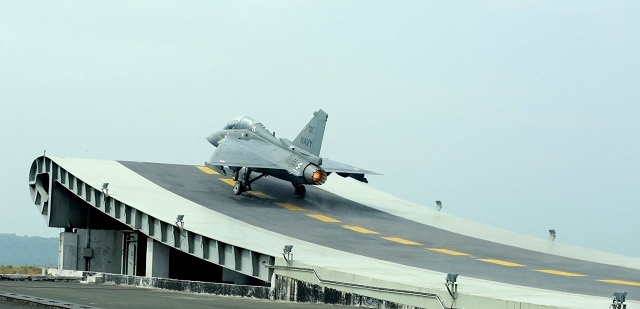|
Video:
LCA Navy first launch from a ski-jump at SBTF |
|||
LCA (Navy) is designed with stronger landing gears
to absorb forces exerted by the ski jump ramp during take-off, to be airborne
within 200 m as against 1000m required for normal runways. It’s
special flight control law mode allows hands-free take-off relieving the
pilot workload, as the aircraft leaps from the ramp and automatically
puts the aircraft in an ascending trajectory. The maiden successful, picture
perfect launch of NP1 from ski jump at Shore Based Test Facility at Goa
is a testimony to the tremendous efforts put in by scientists and engineers
to design the Naval aircraft, its simulator (that helps pilots to know
well in advance how the aircraft will behave on ski jump) and the flight
test team that timed the whole event to near perfection. It can be stated
with conviction “The indigenous Indian Naval Carrier Borne Aviation
program has been launched, literally from the Ski-Jump".
The LCA Navy program team of ADA (Aeronautical Development Agency) is jubilant on achieving the remarkable feat that is the culmination of several years of design, flight test, simulation and management effort with significant contributions from a number of DRDO laboratories. The teams were ably supported by the certification agency, CEMILAC and the quality assurance agency, CRI (LCA). INS Hansa, the Naval Air Station played the perfect host to achieve this significant milestone. The design teams guided by Program Director ADA Shri P S Subramanyam have ensured that all systems meet the stringent requirements of Carrier borne aircraft. Cmde C D Balaji (Retd) as Project Director LCA (Navy) and it’s Chief Designer has been at the helm of affairs right from the concept phase. The team led by Dr Amitabh Saraf indigenously achieved the flight control laws that take care of the problems encountered by a fly by wire aircraft undertaking a Ski Jump Launch. The Shore Based Test Facility (SBTF) has been created to replicate the aircraft carrier with a Ski Jump for take-off and arresting gear cable for arrested landing; by ADA with the participation of the Indian Navy, Goa shipyard, CCE (R&D) West, Pune, R&D Engg (E) Pune and the Russian agencies providing the design support and specialized equipment. |
|||
First Prototype of Indian Made Naval Fighter LCA Navy Completes First Ski-Jump Test
- Posted On











